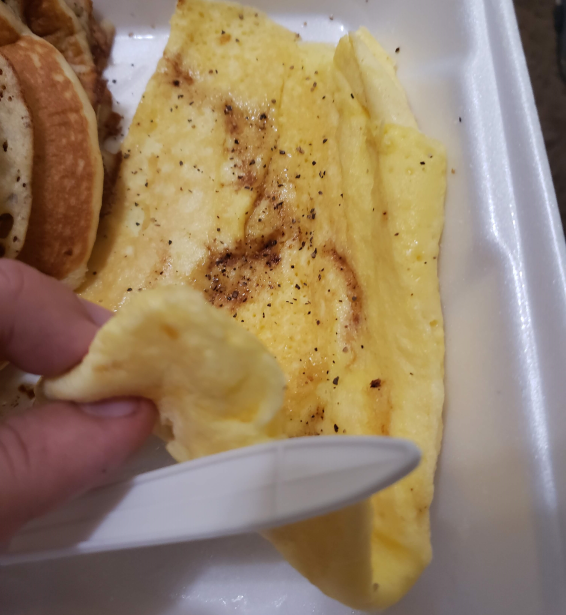QT 111 – Eggs is Eggs and other Scrambled Thoughts

Sometimes, I tell myself lies that I’ll start one of these posts at a reasonable hour. Why hello there! I’m your Tired Tale-teller for Tonight, Jon O’Guin, and today, we’re apparently talking about eggs. I don’t really know why, other than Monday Jon suggested it, and then spent a day and a half working on other projects without ever thinking about if there was enough information here to really make a whole post about. Or, rather, I do KNOW there’s some useful discussion to be had about how to cook eggs, how different countries and cooks do it…but I just don’t yet have the textual tendons to connect the ideas figured out. So…let’s see if I can build a muscle-bound body of work out of a couple slabs of meat, Charles Atlas style.
The Shell Game
Before we get into a lot of this, we have to discuss something I’m pretty sure I’ve discussed on the site before, but it bears repeating because it’s going to be important to some of the cultural styles. Namely the difference between how the US and Europe process and sell eggs. If you’ve ever been in a European supermarket or kitchen, you might have been shocked to see that they leave their eggs sitting out at room temperature.
Here we see the far off European city of “Montreal, Canada”.
Whereas in the US, our eggs are always in the fridge. Why? Because our two systems fight the danger of salmonella differently. See, when a hen lays an egg, the egg is covered in a thin layer of goop that then dries into a functionally undetectable layer called “the cuticle”. This layer of goop is important, because it serves as a kind of natural packaging: the chicken basically laminates the egg, making it harder for bacteria to get in.
Now, in Europe, they mandate that chickens be vaccinated against salmonella, and that eggs CANNOT be washed by farmers or markets, because washing the egg destroys the cuticle. So they know the egg inside is safe, and they can verify how clean a farm is by how dirty the produced eggs are.
Mine are, of course, covered in filth.
Meanwhile, in America, we are, as ever, impressively resistant to government mandates about vaccination, often at our own expense. Since our chickens are NOT required to be vaccinated, we have to keep our eggs refrigerated. Since we’re keeping our eggs refrigerated, we don’t need the cuticle as much (indeed, the cuticle can develop mildew if kept in an overly moist fridge.), so we also wash our eggs…which makes them more susceptible to disease if we don’t keep them refrigerated.
This is important, because the vaccination against salmonella also means that less cooked eggs are less risky in Europe. For context, a bombshell report in the UK showed that, of the 30 billion eggs they produced over a three year span, there were 100 cases of Salmonella. That’s 1 in 3 million. For comparison, the US estimates that probably 1 in 20,000 eggs have salmonella. (Which, sure, “this egg is infected with salmonella” and “I got salmonella from eating an infected egg” are different values, but they’re not 150x different. Our country is not hard-cooking eggs 99.33% of the time.)
So when I tell you that French scrambled eggs can be served with a LADLE
Just spooning those bastards out.
I need you to understand that part of that choice is because that’s just a safer bet for them. As long as you trust your egg sources, or use pasteurized eggs, you can do the same things safely. Or, you know, just try it. In classic American fashion, you can choose to cast off the tyrannical ‘public safety’ recommendations of the CDC and live your life fear of fear. After all, salmonella tends to only kill the elderly, young, and immuno-compromised, it’s not like YOU have much to fear from it. Be a big strong brave warrior like Gaston, and suck down 5 dozen raw eggs to own the libs.
This took a turn I didn’t expect, but suck those shells down, buddy.
That weird detour done, let’s talk texture
A Blood Curdling Egg
And immediately back to weirdness: did you know you can replace eggs in cooking with blood? It’s not typically a useful thing to know, but like, if you can get your hands on pig’s blood around Halloween, you can make extra-creepy and (slightly iron-y) cupcakes or other baked goods.
Trying to find pictures of dried blood leads to a lot of theatrical and gardening supplies, so hopefully I attributed this well enough that the Guardian doesn’t sue me.
Anyhow, I brought that up because we’re back to what we discussed on Monday, the “heat and beat” variables of egg cooking. See, as you cook an egg, the heat you cook it at and the amount you mess with it change how it forms. This is because eggs coagulate when exposed to heat, forming solids. And I figured the best way to get over the kind of gross feeling I sometimes get when hearing “Coagulate” was to specifically point out “Yeah, like blood! You could, conceivably, Fry blood.” (That’s not technically accurate, since blood doesn’t respond to heat the same way…but I mean, you can fry blood SAUSAGE, so it’s technically still correct.)
Little fried pucks of blood. And oats. And spices. I’ve had black pudding. It’s fine.
But yes, eggs set up when exposed to heat, and the higher the heat, the more they’re going to react. As proteins, eggs are susceptible to the Maillard reaction, meaning that if you cook eggs to a solid state, you can then sear them. I don’t know of anyone who’s done this, so I assume there’s some unforeseen complication to the process. (If I had to guess, it’s probably because overcooking eggs creates sulfur compounds, so by the time you’re getting a good seared crust, you’re also making it taste like a matchhead. But only investigation could prove that.) More relevantly, A crucial detail is that eggs will set up in cohesion with contiguous egg proteins. Which is a fancy way of saying “left alone, the eggs will set into one huge sheet of egg”. This is how you end up with diner-style eggs, like the kind I got for breakfast today.
Seen here, covered in bacon residue.
Also, I do not know why I went buck wild on pictures today.
But the more you stir the eggs as they cook, the smaller the curds will be, which in turn creates space for air, butter, and other add-ins. Thus, it shouldn’t be surprising that the softer and smaller the eggs, the more stirring (and gentler heat) is typically called for. Which is hat the heart of the regional variations.
Here an Egg, There an Egg, Everywhere an Egg, Egg.
To start at the soupiest of options, classic French scrambled eggs are made in a double-boiler, and take 20-40 minutes of stirring. Which sounds like a huge pain in the ass (and it is), but it has 2 advantages: 1, it’s very hard to overcook the eggs, and 2, it scales a little more easily. More people tend to have bigger pots and bowls than they do skillets, so if you need to fry 20+ eggs, it’s easier to do in a single long batch than having two batches of American style eggs done 8 minutes apart.
All the goop you can eat.
Next up, British Eggs. British eggs feel more like American eggs, the only difference is they’re stirred more, and taken off a little sooner. There should still be glistening egg liquid on the smaller curds of the British-style, achieved frequently by being a little more rigorous about keeping the heat gentle: many British chefs do a “Half-on” system of egg cooking, where once the eggs start to set up, they start spending half the cooking time with the pan on the burner, and half the time off, in order to moderate the heat. The result is a medium curd, much moister type of scrambled eggs.
I kept these zoomed out to include all the logos, so the shots may be a little hard to get the details on. Just google the video for more.
Lastly, American style: At its most fundamental level, you just stir the eggs less, using a longer motion, kind of pulling the edges of the egg in to the middle of the pan, kind of “piling up” long sheets of egg. Or just let it cook out, almost like an omelet: a single unified sheet of egg. The result is typically a little drier, in a “no residual uncooked egg” level. These eggs are by no means bad, but they’re edging into a risky territory. Think of the as the “medium well” of eggs: while well-done steaks are largely considered “too cooked” by chefs, so to are “rubbery eggs” a go-to example of poor cooking, and American eggs get closer to that standard before being finished. They’re not there yet, but they’re getting close.
This is a little wetter than many, but you can hopefully see the larger curds.
Umm…what else…oh, I guess I can cover some of these.
Famous Egg Recipes and Tips
I’ve talked about this one before, but scrambled eggs are a great neutral protein for trying out how different flavor combinations work together. If you have a spice mix you don’t really know well, try it in/on some scrambled eggs.
In a similar vein, at least one cooking site suggests adding a teaspoon of garlic powder per 2 eggs to your scramble routine. Supposedly this will add extra umami flavor to the eggs, and add the health benefits of garlic. As someone who loves garlic, I’ll be sure to give it a try soon and let you know.
Gordon Ramsey has a famous recipe from his home-cooking series, which is a great way to see how much calmer he is when not being paid to scream at professional chefs. He has some claims in the video that have been contested (like, the “don’t salt before the pan or they’ll change the chemical nature of the egg, making them more watery” line is…close to correct, in that salt will prevent the eggs from setting firmly… meaning they’ll squeeze out LESS water. The curds will be wetter INSIDE.)
Heston Blumenthal, a big name in “multi-sensory cooking” and the weird intersections of food and perception (Like, if you tell people they’re getting a “Chilled smoked salmon mousse”, they love it…if you hand them the same dish with “smoked salmon ice cream”, it’s weird and gross.) has a French style recipe, which is served with browned butter and sherry vinegar.
For one of his seafood dishes, you get an iPod to lsiten to the sea as you eat.
Speaking of: Dairy. You don’t NEED dairy in eggs, but if you want really creamy eggs…I mean, the word ‘cream’ is RIGHT THERE. Most recipes call for butter, or milk, or heavy cream. More exotic ones (like Gordon’s) might use tangier Crème Fraiche. I’m sure you can make a solid version with sour cream or crema Mexicana. I’d warn you that it makes the dish non-vegan, but…you know, eggs.
If you’re lactose intolerant, a similar hack can be achieved with cornstarch/potato starch and water.
And that’s probably enough egg information to let me feel like I’ve covered all my bases for today. Hopefully you learned something. IF you didn’t, I guess that’s egg on my face.
MONDAY: I DID THAT THING WHERE I FORGET THURSDAY EVENING IS THE ONLY RECURRING TIME MY FAMILY TALKS TO EACH OTHER, SO I PROMISED TO HAVE SOMETHING ESTABLISHED BEFORE I COULD. WORST CASE SCENARIO, WE’RE TALKING HOT DOGS.
THURSDAY: EAT YOUR EGGS AND STOP ASKING QUESTIONS.
















